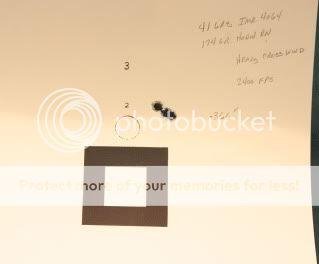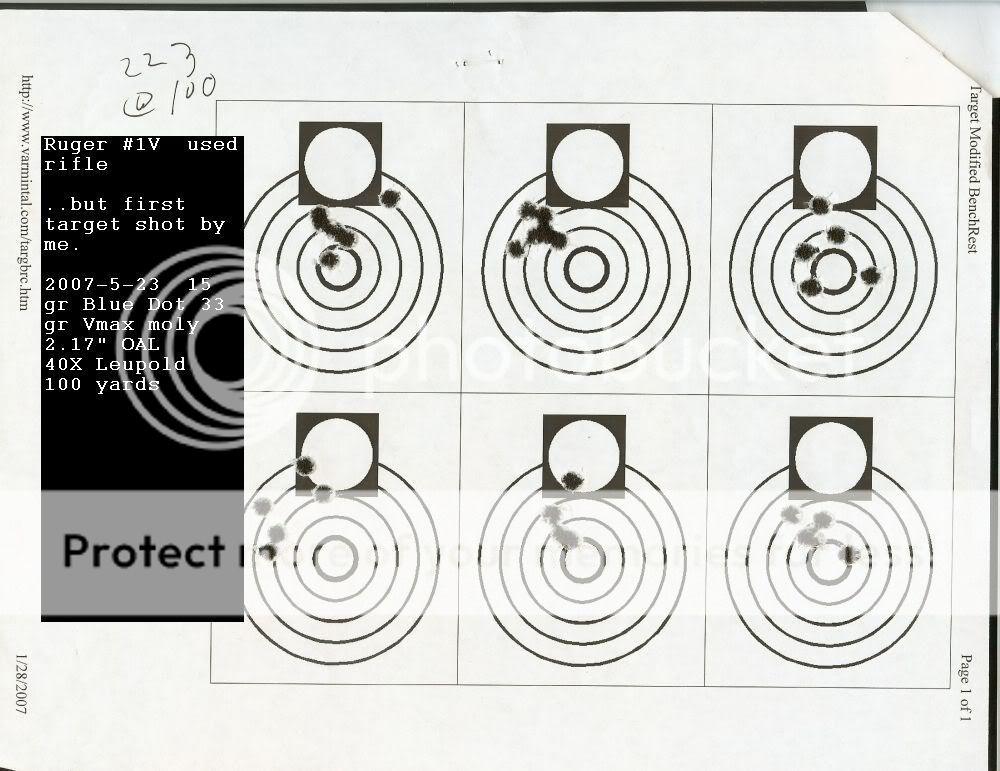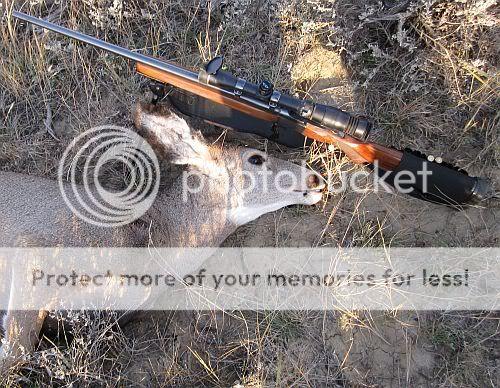I spent a hour or so posting everything I know about #1 accuracy, the darned thing disappeared when I hit send. I hate computers!!
I bought my first #1 a 6mm "B" as we refer to it now, in 1967 two months after it was released for retail sales. Actually you ORDERED your new #1 from a dealer or direct from Ruger within certain parameters. Barrel weight and length, cartridge it was chambered in, fore arm choice and sighting choice. You could order the standard 26" barrel of "B" weight but elect to have it drilled and tapped for scope blocks. From 1967 to 1973 the scope blocks were NOT Ruger and were not supplied. They were 7 1/4" a[art and required the use of old style long tube scope with external adjustments, Unertl Lyman,etc. The first internally adjustable I remember that fit that bill was the 3200 Redfield. I still have one on a 1971 2506 "V". The "V: weight barrel was not in production until 1970 in the 22-250 "V" Prior to that if you were "building" a varmint rifle from the Ruger factory you ordered a "B" with blocks or at least drilled for them. In 1974 Ruger began drill the third set of holes back closer to the receiver at a 3 1/2: spacing that allowed the use of Ruger supplied blocks and rings and the more modern short/internally adjustable scope.
As scopes get short they have had to add the off set rings to get short tube scope to fit and even then not all scopes will work on a #1 whether it has blocks or the factory rib. Early on Buehler, Redfield and Conectrol made blocks that used the Ruger drilled holes and studs for the rib and replaced them and allowed the use of Redfield style scope rings and gave you external adjustment for windage. Buehler made a cantilevered base that used the rear st of factory scope block holes and the drilling /tapping of one more hole, hidden by the base that allowed mounting a more modern scope on the "V" before the drilled the third set of holes in 1974. I have a 1972 22-250 "V" that still wears this base and Buehler rings and a 6x18 Redfield that has accounted for thousands of dead varmints.
The early #1s from 1967 through about serial 130-05000 (Mid 1973 or so) were supplied with Douglas Match grade barrels, even in the light weight 22" barrel we now refer to as the "A" barrel
Enough history. The early rifles had a lot of hand fitting and a 3 screw fully adjustable trigger or at least down to 2 pounds and routinely shot....very well.
One has to remember that Bill Ruger always thought of the #1 as a "HUNTING" rifle and if yu were getting 2" five shot groups it was well within spec and minute of der. If you sent it back to Ruger because YOU could only get 2" groups they would send it right back. I have several of those letters.
How accurate are #1s is always the question. I probably own a hundred or so in the last 47 years. I've sold or traded some off over the years but nevr because it wuldn't shoot. The one that never shot well is sill here. My dad killed his last deer with it ad that ones here to stay regardless of accuracy.
The problem guys need to understand is that the #1 and any other falling block single shot rifle with a 2 piece stock has the same issues. Barrel harmonics and return to "battery" consistently
The very best #1s will ou tshoot many/most bolt guns with some /a lot of work. The best bolt guns will always out shoot the best #1s. It's simpy a matter of engineering and limitations. When you close the action on a bolt gun you are engaging the lugs and camming the barrel back into the receiver under tension and making the rifle a homogeneous construct. If it happens to be a solid bottom single shot on a short action with as little steel removed for the port then it's REALLY rigid
Regardless of how tight you breach a #1 or other falling block, when you close the lever and raise the block you are forcing the surface APART. Then there are the issues of the two piece stock and how you handle that.
All most of this information is over on the #1 Group on Yahoo for the looking.
The files section contains accuracy tips, reliable/trusted smiths and scores from our annual shoots.
Most #1s, regardless of age and barrel maker should be able to shoot at or near MOA with the load and bullet weight it prefers. We are back to barrel harmonics and where it comes to rest between shots. Most #1 shoot best with some upward pressure on the barrel. The #1 is designed with a bearing pad of wood at the tip of the barrel channel to exert this pressure. Way back in the 60s and 70s we were drilling the tip of the fore arm hanger and installing a set scew to bear on the bottom of the barrel. That sometimes increased accuracy and consistency. It's much easier now with the Hicks Accuizer that does the same thing but without drilling the hanger. It does require removing some wood inside the fore arm and sometimes works wonders.
Even without doing this groups can usually be improved by finding the fore arm pressure your rifle likes. No two are the same. If you have tried a series of loads and bullet weights you should find that your #1 prefers a specific load. If yu find that, then remove the forearm and shoot a group without it by resting the action directly on your rest or bags. Then re install the forearm just barely snugging the fore arm attachment screw. Shoot another group and then tighten the screw at some point the group will either improve more or go to Hell. Keep track of the number of turns or use an inch pound torque wrench so that this setting is repeatable.
Load work and barrel harmonics usually will get you near MOA and is where I usually quit with hunting rifles.
One note on the tip pressure. Joe Miller the owner of the #1 Group, #1 guru and all around nice guy came up with a newer fix about 5-6 years ago. He noticed that an older Model 52 Target gun he owned and had used for years actually had a piece of rubber in the forearm tip, from the factory. He did some experimenting and came up with the Unpatented Miller Little Rubber Thingy. I have now gone that route with most of the 37 #1s I actually shoot. Use a dowell and sandpaper and remove the wood at the tip of the forearm in the barrel channel. Then replace it with a piece of truck inner tube about 1" long that cover the inside of the barrel channel and exerts upward pressure as the fore arm is tightened. It does seem to work and stands to reason that over time the wood at this location gets battered under firing and over time changes density and gets harder, thus changing pressure. The rubber seems to allow the rifle barrel to more uniformly return to the same position from shot to shot and to dampen some of the whip/vibration of the barrel upon firing. Nearly all my hunting rifle #1s wear them now and all the varminters and target ones for sure.
#1 "V"s can be made to shoot at or near 1/2 MOA. Usually with the above and the addition of a good trigger or working over the factory trigger. The older 3 screw trigger was adjustable down to about 2 pounds and for creep and backlash. The Moyers trigger is simply a copy of this trigger. The new 2 screw triggers are NOT adjustable for trigger pull. You can stone the surfaces but it's not recommended and Ruger will send your rifle back either untouched or with a new factory trigger in it if they judge your modifications to be unsafe. The Canjar Single set was/is a great #1 trigger but out of production and hard to find. Right now the best seems to b the Kepplinger set trigger, it is spendy but work very well. I know the Jard trigger is out there but have not used it and not enough guys have actually used and tested them enough to offer a informed opinion.
I have factory "V"s in 204, 223, 22-250, 220 Swift, 243, 6mm, 25-06, 6.5 Creedmore, 7mm Rem Mag and 300 Win Mag, All shoot sub MOA except the two Mags, with their preferred load.
Now we get to the really trying to get them to shoot with a cartridge known to be inherently accurate into a tiny bug hole. The above alterations if necessary and MORE load work and precision reloading and brass prep. Then replace the factory hammer or lighten the one you have. The factory hammer weighs 785 gr. If you watch through a high power scope and dry fire the #1 with the factory hammer you can see the rifle deflect up to 1/8" under the hammer blow. The Moulds Speed hammer weighs 340 gr and the Competition hammer slightly less and come with a lighter main spring. You can cut one coil off the factory spring and get close. You can run into some reliability issues if it's all too light so it's certainly not anything I recommend for a hunting rifle. Sadly he, Moulds is ill and the hammers are getting hard to find. Brownells or AE Brown no longer list them.
I have Factory "V" with factory barrels that I have gotten serious with this includes a 22PPC and a 6mm PPC along with a factory barreled "B" that started life as a 218 Bee but became a 22BR and semi cusom rifles in 6mm BR and 257 Roberts "V"
The stocks are all factory wood stocks but they were pain but straight grained. All checkering was removed and the forearm bottoms sanded flat. They were painted ala bench rest rifles to make them smoother and the sling studs removed and the holes glassed in. Several have Teflon patches so they slide through the rear bag and across the front rest better. It's taken YEARS of tinkering and LOTS of load work/developement. This includes stuff that no hunting rifle needs but includes bullet grad in the case, measure and quantified, seating depth in increments of .001 and anything else I can think of. I ran through about 500 cases for the 22 PPC just to find 40 that all weighed within .01 of each other. Nearly all RELOADING scales are plus/minus .1 grains
Does it work? Our annual shoot is a postal shoot. it's divided into 4 categories by caliber. Any modification is allowed. You shoot two targets within 20 minutes and the two FIVE shot groups are averaged for group and the score is also the combination of the two targets, standard BR targets.
I finally beat Joe in the .224 or under class in 2013. It's taken 4 or 5 years. The group average was .424 and the score was 100 with 9 Xs. One group was in the .3s but my second opened up a bit, That was me not the rifle/load.
He did continue to beat me in the under .30 cal class with his 6mm PPC. I placed second. Again one great target and I threw a called flyer into the outside of the ten ring on the second group. I think the average was in the mid .5s with a score of 100 with 8 Xs.
I didn't compete with anything above .30 caliber but Joe won it also with a custom 30BR with a combined groups into the .4s and a 100 score.
The above .40 was won by a nearly factory 45-70 shooting slow caste bullets in just over 2".
The scores and groups are posted for the annual shoots in the files section.
Of the 5 I own that I have messed with the most all are true sub 1/2 MOA guns.
The smallest group of five shots I have ever fired with any #1 was .315 at 100 meters with my semi custom #1 "V" in 257 Roberts that Doug Shilen barreled for me in 1970 with a barrel that matched the take of 22-250 "V" barrel but carried on the factory taper to 28". It was designed around one bullet and one load with a 75 gr Sierra HP loaded at 2.75 OACL with the bullet JUST touching the lands.
The fun part is that other than the barrel that rifle is nearly stock and still wears it's factory trigger and wood, unaltered.
Now is it WORTH all the time and trouble? I'd have to say, YES. I have no idea of the thousands of hours of enjoyment I have realized in the shop or reloading room and at the range getting there.
I have many blt guns that are more accurate. Heck I need to do is by a Stolle or other custom BR rifle frm a guy that gets tired or wants to move one. They make great varmint rifles. BUT the come shooting tiny groups with the load work done etc.
Buy a Nosler Custom, it's guaranteed to shoot 3 shots into 1/2" WITH the load they worked up. Fun to hunt with, but not a lot of fun to tinker with. Spend $5K o a custom Stolle or other BR gun at it's already shooting bug holes with THE recommended load when it arrives. I have nothing to do with that other than pulling the trigger.
I much prefer spending the time and effort on a rifle like the #1 that requires some experimenting and attention to detail to truly shoot it's best.
Of all the rifles I own, and I own a LOT, I take more pride of ownership in my #1s
than nearly anything else and certainly more than things that cost thousands more.
Only you can answer whether it's worth it BUT you will enjoy your #1 even if all you do is hunt with it a couple times a year. As I read the previou s posts they seem to hold true with the old adage. You either don't own any #1s or you own all you can afford. There's very little middle ground.

Just a quick aside. I have NEVER glass bedded a fore arm. I simply don't see the point and have never had to. While guys have gotten decent result free floating barrels, none of the really serious #1 shooters do so. You can NOT shoot a #1 hot enough that cutting the barrel rib in half to relieve differential expansion makes a bit of sense. Same wirth releaving the rear of the rib UNLESS it is really bearing heavily against the receiver. If I happen to have a rib off I check and a few file stokes and some cold blue will resolve the issue. As I usually stop at MOA with hunting rifle ha wear ribs this is seldom if ever needed. LOTs of smiths have lots of ideas on #1s. Few are basing it on anything other than hearsay and fewer yet have ever worked on an appreciable number of #1s. They job is to spend your money. Most #1s do NOT need to be re barrel to an after market barrel just to shoot MOA. I have made many over the years in wildcats that couldn't be made from factory barrels. I've used Douglas, Shilen, Hart, Lillja and nearly every other well know barrel maker. None have shown a vast improvemnt over factory barrels. The issues are seldom the barrel itseelf
The same issues exist with Browning 78s and 85s and original Highwalls. You can buy a $6000+ Dakota single shot and it will work with the recommended load. Just don't switch bullets, powder or anything else. Most of that $6K is wood and workmanship and attention t detail that hand building buys. It does NOT overcome the basic issues involving a falling block single shot. Trust me I know. I sold the darned Dakota and bought 5 more #1s.

the best
Ross



